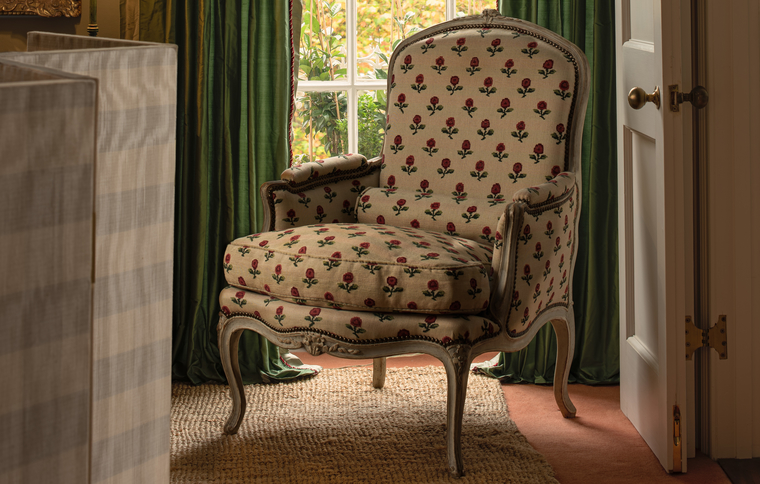Stamped with approval: a selection of fine 18th century French furniture
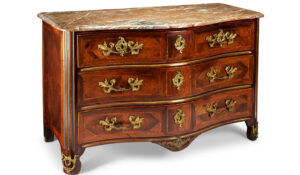
A Régence kingwood and tulipwood parquetry serpentine commode by Jean-Charles Saunier
The 20th July auction of Fine Interiors at The Pedestal features an extremely fine group of 18th century French furniture bearing the prized stamps of renowned master makers.
The 18th century witnessed a magnificent age in French furniture production where the exceptional craftsmanship of cabinetmakers was combined with the skills of carvers, ornamentalists and gilders. Artists and craftsmen working in the 18th century practised their trades according to guild guidelines set out in the Middle Ages and little changed over the centuries since. The Parisian guild of furniture makers, the Corporation of Menuisiers, stipulated at least six years of training culminating in the production of a chef-de-oeuvre, with the title of maitre conferred upon the approval of the piece. The JME element to a stamp indicates that a committee of guild members had made regular inspections of the maker’s workshop and had also endorsed the quality of the particular piece. The guild system was abolished in 1791 during the French Revolution and thereafter complete freedom in the production of all crafts was permitted.
From Louis XIV through to the Directoire period items were created in splendid materials embellished with impressive ornamentation. Sophisticated, expensive and time consuming techniques elevated many pieces of furniture to works of art status the demand for which was fuelled by the French court, nobility and a growing class of bourgeoisie all hungry to dress their interiors with the latest, exclusive pieces.
————————————-
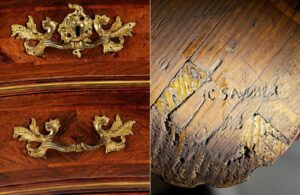
Gilt brass details from the commode | I C SAUNIER JME stamped to the underside of the marble top
The commode became an increasingly popular form in the Régence era, and the gilt bronze mounts, flowing curves and the use of kingwood veneers seen here are typical features of such early 18th century pieces. This Régence kingwood and tulipwood parquetry serpentine commode with a shaped rectangular pink and grey breccia moulded marble top, is stamped twice to the underside of the marble, I C SAUNIER JME. Jean-Charles Saunier, maître 1743, was the son of ébéniste Charles Saunier, and he took over his father’s workshop in the Rue du Faubourg Saint-Antoine, Paris, where he remained active until the mid-1760s. He was aided by his own son, the better known ébéniste Claude-Charles, whose furniture was to be supplied to the French Royal family at Versailles and Choisy.
The Louis XV period is regarded as the apogee in 18th century furniture design, with a more sensuous and playful look and the moderate use of curved lines. Louis XV’s chair maker, Jean-Baptiste Tilliard, created the bergère – a curved armchair with a low seat and exposed wood frame, highly carved and with fabric covered panels between the arms and seat. The bergère was free-standing and with its potential for decoration was designed to be moved around rather than staying in place against a wall.
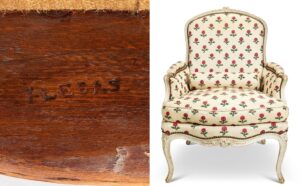
I LEBAS stamped to the seat-rail | Louis XV grey painted bergère by Jean-Baptiste Lebas
This Louis XV grey painted bergère by Jean-Baptiste Lebas, maître 1756, is upholstered and close-nailed in cream fabric with red and green floral sprigs, with outswept padded arms, it rests on cabriole legs and scroll feet and the seat-rail is stamped I LEBAS. Jean-Baptiste Lebas (1729-c.1800) worked from the rue de Cléry, and numbered among his clientele the comtesse du Barry, the last maîtresse-en-titre of Louis XV, for whom he produced furniture for the Château de Louveciennes – the 17th century mansion was expanded and re-decorated by Ange-Jacques Gabriel for the comtesse. Another of Lebas’ clients was the comte d’Artois, who later reigned as Charles X, the last Bourbon king of France.
Whereas the fauteuil design dates from early 17th century France, and this pair of Louis XV grey painted fauteuils à la reine by Louis Falconet, maître 1743, is upholstered and close-nailed in adapted mid-18th century needlework depicting Spring and Winter, with animals, birds and flowers. With outswept padded arms and serpentine padded seats, on cabriole legs and scroll feet, with the seat-rail stamped L FALCONET.

Pair of Louis XV grey painted fauteuils à la reine by Louis Falconet, inset: L FALCONET stamped to the seat-rail
The following pieces, a canapé and a pair of chaises both demonstrate the return to symmetry, straight lines and classical ornamentation seen in the Louis XVI era. Interest in Greco-Roman antiquities following the discovery of the ancient city of Pompeii in 1748 continued through to the second half of the 18th century, along with the use of motifs derived from nature. Despite Marie-Antoinette furnishing her apartments with deliberately smaller items of neoclassical furniture, expensive materials were still favoured along with the work of highly skilled artisans. The straight, tapered leg replaces the cabriole of the Régence and Louis XV periods, accompanied by a resurgence in turned elements.
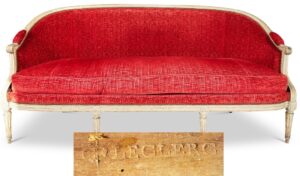
Louis XVI grey painted canapé by Claude Leclerc, inset: C. LECLERC stamped to the seat-rail
The Louis XVI grey painted canapé, by Claude Leclerc, maître 1785, is upholstered and close-nailed in red patterned velvet, on turned reeded tapering legs headed by paterae and stamped twice to the seat-rail C. LECLERC.
Louis XVI cream and gilt chaises, by Jean-Baptiste Lelarge, maître 1775, are upholstered in green and cream diapered pattern cut velvet, on stuff-over seats and moulded seat-rails and on turned tapering reeded legs headed by paterae on spool feet, both chaises are stamped I B LELARGE under the seat-rails.
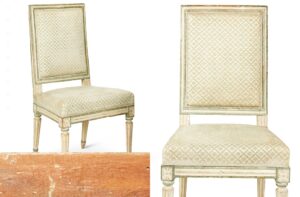
Pair of Louis XVI cream and gilt chaises by Jean-Baptiste Lelarge, both stamped I B LELARGE under the seat-rails
The day bed or récamier is one of the most notable pieces of furniture from the Directoire era, and was made famous through the celebrated portrait of the beauty, Madame Récamier, by Jacques-Louis David.
This late 18th century French Directoire carved mahogany day bed, is by Georges Jacob (1739-1814), maître 1765. Its rectangular padded seat with loose squab cushion upholstered in green cut velvet, the sides with baluster turned top-rails, on outswept sabre legs and stamped under seat rail, G IACOB.

Late 18th century French Directoire carved mahogany day bed by Georges Jacob
The day bed exhibits the elegant and refined ‘Etruscan’ style deployed by Jacob from the 1780s. Among the most celebrated seat furniture he created are the chairs supplied in 1787 to Marie-Antoinette’s dairy, at Rambouillet – the chateau acquired by Louis XVI in 1783. Jacob’s output included carved, painted and gilded beds, seat furniture and upholstery. Arriving in Paris, from Burgundy, in 1754, he was apprenticed to Jean-Baptiste Lerouge, a chair maker, where he met Louis Delanois, a seat furniture specialist whose neoclassical designs were to greatly influence Jacob. It is likely that Jacob was a journeyman with Delanois for around 3 years in the 1760s. Jacob set up his own premises rather than taking the more usual and certainly easier route of marrying into an existing business and his later years were spent in the production of furniture for Napoleon’s numerous residences.
